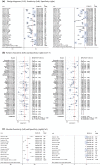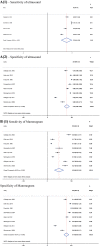Diagnostic Accuracy of Nipple Discharge Fluid Cytology: A Meta-Analysis and Systematic Review of the Literature
- PMID: 34839426
- PMCID: PMC8627297
- DOI: 10.1245/s10434-021-11070-2
Diagnostic Accuracy of Nipple Discharge Fluid Cytology: A Meta-Analysis and Systematic Review of the Literature
Abstract
Background: Nipple discharge is the third most frequent complaint of women attending rapid diagnostic breast clinics. Nipple smear cytology remains the single most used diagnostic method for investigating fluid content. This study aimed to conduct a systematic review and meta-analysis of the diagnostic accuracy of nipple discharge fluid assessment.
Methods: The study incorporated searches for studies interrogating the diagnostic data of nipple discharge fluid cytology compared with the histopathology gold standard. Data from studies published from 1956 to 2019 were analyzed. The analysis included 8648 cytology samples of women with a presenting complaint of nipple discharge. Both hierarchical and bivariate models for diagnostic meta-analysis were used to attain overall pooled sensitivity and specificity.
Results: Of 837 studies retrieved, 45 fulfilled the criteria for inclusion. The diagnostic accuracy of the meta-analysis examining nipple discharge fluid had a sensitivity of 75 % (95 % confidence interval [CI], 0.74-0.77) and a specificity of 87 % (95 % CI, 0.86-0.87) for benign breast disease. For breast cancer, it had a sensitivity of 62 % (95 % CI, 0.53-0.71) and a specificity 71 % (95 % CI, 0.57-0.81). Furthermore, patients presenting with blood-stained discharge yielded an overall malignancy rate of 58 % (95 % CI, 0.54-0.60) with a positive predictive value (PPV) of 27 % (95 % CI, 0.17-0.36).
Conclusions: Pooled data from studies encompassing nipple discharge fluid assessment suggest that nipple smear cytology is of limited diagnostic accuracy. The authors recommend that a tailored approach to diagnosis be required given the variable sensitivities of currently available tests.
© 2021. The Author(s).
Conflict of interest statement
Natasha Jiwa is a PhD candidate investigating nipple biofluid in the early detection of breast cancer under the supervision of D. R. Leff and Z. Takats. The remaining authors have no conflicts of interest.
Figures




References
-
- Chen L, Zhou W-B, Zhao Y, et al. Bloody nipple discharge is a predictor of breast cancer risk: a meta-analysis. Breast Cancer Rest Treat. 2012;132:9–14. - PubMed
-
- Cancer Research UK. Breast Cancer Statistics. Retrieved 30 January 2021 at https://www.cancerresearchuk.org/health-professional/cancer-statistics/s....
-
- Filipe MD, Patuleia SI, de Jong VM, Vriens MR, van Diest PJ, Witkamp AJ. A network meta-analysis for the diagnostic approach to pathological nipple discharge. Clin Breast Cancer. 2020;20(6):e723–e748. - PubMed
-
- Wrensch MR, Petrakis NL, Miike R, et al. Breast cancer risk in women with abnormal cytology in nipple aspirates of breast fluid. J Natl Cancer Inst. 2001;93:1791–8. - PubMed
Publication types
MeSH terms
LinkOut - more resources
Full Text Sources
Medical

